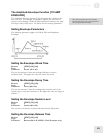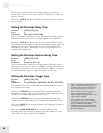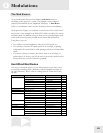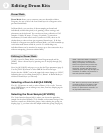
Modulations
8
51
• PEDAL 2: Although there is no Pedal 2 jack on the QS, it is available
as a modulation source via MIDI controller messages. The Pedal 2
modulation source defaults to MIDI Controller #4 (Standard Foot
Controller). It is possible to assign it to a different controller number
if you wish on Global Mode, page 13.
• PLFO/FLFO/ALFO: You can select the Pitch, Filter and
Amplitude LFOs as modulation sources, even if they aren't being used
to affect the Sound in their usual ways.
• PENV/FENV/AENV: The Pitch, Filter and Amplitude envelopes
can also be selected as modulation sources. Try routing them to LFO
speeds or the Effect Send Level of a Sound.
• RANDOM: This provides a different modulation value every time
you hit a key. Example: With vintage analog synth patches, use pitch as
the destination and apply a very slight amount of random modulation.
Each note will have a slightly different pitch, which simulates the
natural tuning instability of analog circuits.
• TRIGATE: This is the Trigger Rate Follower, which monitors how
fast notes are being played on the keyboard. For example, if routed to
the Effect send of a Program, you could automatically have more
effect when playing quickly, and less effect when playing slowly.
• CNTRL (A, B, C, D): These are the four [CONTROLLER] sliders
on the front panel. Since these sliders also have MIDI controller
numbers assigned to them, they can be remotely controlled via MIDI.
The MIDI controller numbers are assigned in Global page 8-11.
• TRACKGEN: This is the output of a signal processed by the
Tracking Generator module.
• STEPTRAK: This is the output of a signal processed by the
Tracking Generator module in stepped mode.
Choosing the Mod Destination
Buttons: [EDIT] [0-5 MOD]
Page: 2
Parameter: Dst (see below)
Here, you can select from the following modulation destinations. You
can find out more about these parameters and how they affect the sound
in their respective sections:
• Pitch • Filter LFO Speed • Amp Envelope Delay
• Filter Frequency • Filter LFO Amp • Amp Envelope Attack
• Amplitude • Filter LFO Delay • Amp Envelope Decay
• Effect Send • Filter Envelope Delay • Amp Envelope Sus. Decay
• Pitch LFO Speed • Filter Envelope Attack • Amp Envelope Release
• Pitch LFO Amp • Filter Envelope Decay • Amp Envelope Amp
• Pitch LFO Delay • Filter Envelope Sus. Decay • Portamento Rate
• Pitch Envelope Delay • Filter Envelope Release
• Pitch Envelope Attack • Filter Envelope Amp
• Pitch Envelope Decay • Amp LFO Speed
• Pitch Envelope Sus. Decay • Amp LFO Amp
• Pitch Envelope Release • Amp LFO Delay
• Pitch Envelope Amp
TIP: If you want to modulate the pitch or
filter Envelope Level positively, set the
Envelope Level to zero so you have room to
modulate. For the amplitude envelope, set
the level to 01. Similarly, if you want to
modulate any Envelope Level negatively, set
the Envelope Level to 99.
NOTE: When negatively modulating the
amplitude envelope, make sure the negative
modulation amount is not greater than the
Aenv Level setting. For example: If your
Aenv Level is at 59 and you have Controller
A routed to AENV AMP with a mod amount
of -60, any note held down when Controller
A reaches its maximum throw will be
considered “off” and will be unable to be
pulled back up by Controller A. You'll have
to re-trigger the note.
NOTE: When Portamento Rate is chosen as
a destination, you will hear no change in
that parameter unless it is at least set to 01.


















